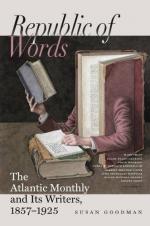“The living fountain overflows
For every flock, for every lamb,
Nor heeds, though angry creeds oppose
With Luther’s dike or Calvin’s
dam.”
He spake; with lingering, long embrace,
With tears of love and partings fond,
They floated down the creeping Maas,
Along the isle of Ysselmond.
They passed the frowning towers of Briel,
The “Hook of Holland’s”
shelf of sand,
And grated soon with lifting keel
The sullen shores of Fatherland.
No home for these!—too well
they knew
The mitred king behind the throne;—
The sails were set, the pennons flew,
And westward ho! for worlds unknown.
—And these were they who gave us
birth,
The Pilgrims of the sunset wave,
Who won for us this virgin earth,
And freedom with the soil they gave.
The pastor slumbers by the Rhine,—
In alien earth the exiles lie,—
Their nameless graves our holiest shrine,
His words our noblest battle-cry!
Still cry them, and the world shall hear,
Ye dwellers by the storm-swept sea!
Ye have not built by Haerlem Meer,
Nor on the land-locked Zuyder-Zee!
* * * * *
ART.
THE HEART OF THE ANDES.
We Americans, amidst the confusion and stir of material interests, are not inattentive to the progress of those claims whose growth is as silent as that of the leaves around us, and whose values find no echo in Wall Street.
With the spring there has bloomed in New York a flower of no common beauty. All the fashion and influence there have been to hail this growth of our soil at its cloistered home in Tenth Street. There is but one opinion of the beauty and novelty of the stranger. It is of the “Heart of the Andes,” by Mr. Frederick E. Church, we speak. This artist, now known for some years as he who has with most daring tracked to its depths the witchery and wonder of our summer skies, and the results of whose two visits to South America have ere this shown how sensitive and sure the photograph of his memory is, gives us from the trop-plein of his souvenirs this last and crowning page.
We hold the merit and charm of Mr. Church’s works to be, that they are so American in feeling and treatment. What chiefly distinguishes America from Europe, as the object of landscape, is, that Europe is the region of “bits,” of picturesque compositions, of sunflecked lanes, of nestling villages, and castle-crowned steeps,—while with us everything is less condensed, on a wider scale, and with vaster spaces.




